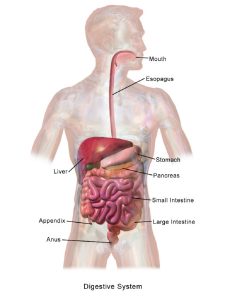Parts of Digestive System in Humans
Parts of the Digestive system include
- Buccal cavity and its parts
- Esophagus
- Stomach
- Small intestine
- Large intestine
- Rectum, and anus.
Buccal cavity and its parts:
It includes teeth, tongue, and secretions from the salivary glands.
- Teeth help in the chewing of the food.
- The tongue helps in mixing the saliva with food.
- Secretions from salivary gland include salivary amylase. Salivary amylase break complex starch into maltose sugar. Saliva also contains mucus. Mucus lubricates the food and prepares the food for its easy passage.
Esophagus
The esophagus is the flexible tube-like pipe that connects the buccal cavity with the stomach. Masticated food from the oral cavity passes into the esophagus. The esophagus opens into the stomach and the food from the esophagus pass to the stomach. It has two sphincters. One just below the buccal cavity and another just above the stomach.
Sphinctor below the buccal cavity is called upper esophageal sphincter (UES); while the sphincter just above the stomach is Lower esophageal sphincter (LES). Both the sphincter prevent backward movement of the food particles except during vomiting.
Stomach
The stomach is a thick-walled muscular cavity. Its muscular wall help in churning the food particles into more smaller particles. It also secretes Gastric juice. Gastric juice contains hydrochloric acid and pepsin. The acidic environment prevents the growth of the microorganisms and kills the germs. It also activates the pepsin. Pepsin is a digestive enzyme. It breaks down the proteins into simpler amino acid.
Small intestine
The small intestine is a long coiled tube-like structure present below the abdomen. It receives the secretions from the liver (bile juice) and the pancreas (Pancreatic juice). Bile juice emulsifies the fats and breaks them into small fat globules. It also neutralizes the PH of the intestine as trypsin from the pancreatic juice needs an alkaline medium. Pancreatic juice contains pancreatic amylase, lipase, and trypsin. Pancreatic amylase degrades complex starch into sugar; lipase breaks fats into a simple chain of fatty acids and; trypsin degrades arginine and lysine-containing amino acids into simpler amino acids.
The small intestine is the primary place for the absorption of nutrients from the food. Finger-like projection called Villi (sing: Vilus) surrounds the inner linings of the small intestine. Villi increase the surface area and help in enhanced absorption. Thin blood vessels richly supply these villi and transport nutrient throughout the body.
Large intestine
Undigested food particles now pass into the large intestine. The large intestine absorbs water from the undigested food and turns undigested food into hard feces.
Rectum and anus
Faces pass through the rectum and come out from the anus. The anus contains anal sphincter. The anal sphincter is under the voluntary control of the brain and opens when we feel the need for defecation.
Reference:
Why It Matters – Digestion.

Why Saliva is having Salivary Amylase??